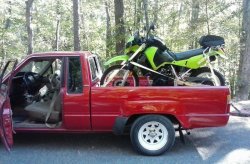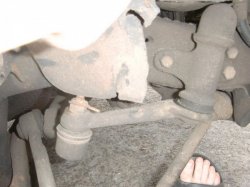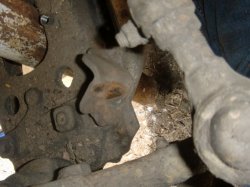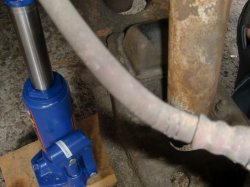I don't even know what to ask, I'm at the very bottom of this learning curve.
I've only had the '85 2WD extended cab for a little while. There are big problems and there are many small problems. I don't even know what the search terms are to find more info.
I'd really appreciate any advice. I've been working on motorcycles a long time but hardly any experience with autos.
Hard Start: I'm trying way to hard to get this thing started. I have to pump the gas and turn the starter motor way too long before it will fire up, and then I have to keep my foot on the gas pedal to keep it from shutting off for a few minutes. It must have some kind of choke or enrichener, like a motorcycle, but darned if I know what it looks like to check it out. I finally got my Haynes but the terminology is over my head and the photos are lacking. The weather is cooling off and I know for sure that this truck isn't going to start on a cold morning the way it is now. What can I do?
Brakes: The brakes are pitiful even by 1985 standards. The pedal plunges almost to the floor before I get any braking, and it pulls hard to the right if I really need to get on the brakes hard. It seems I nearly rear-end someone every time I drive (I live in the city, you can't maintain a safe following distance, somebody just jumps in there in their Odyssey and slams on brakes in front of Starbucks).
Front stuff connected to the wheels: I don't even know what these parts are called, or how to tell if they're bad. I just know the right side of the truck sits lower than the left side and when I hit even a small bump it's hard to keep the truck from moving out of the lane. Some kid in a Civic already hit me (his fault) and I had him help me straighten the front bumper to keep insurance from ruining him. It was a light hit but during the repair, I could see where the front right suspension stuff and tie rods and ends and whatever all that is, had once upon a time hit against each other or the frame. Heck I guess I need to go get photos.
I don't even care about the little stuff compared to these issues, like the tailgate that falls open every bump, the shot rear suspension, the inoperable high beams and other little electrical stuff, the compressor that's there but has no belt, missing window trim, and the most pitiful attempt to wire speakers that I've ever seen.
I'd just really appreciate help with the carburetion/choke issues and taking care of the front end before something fails completely.
I have had experience putting shocks and ball joints on my husband's Tacoma, but that's about it.
Help please?
I've only had the '85 2WD extended cab for a little while. There are big problems and there are many small problems. I don't even know what the search terms are to find more info.
I'd really appreciate any advice. I've been working on motorcycles a long time but hardly any experience with autos.
Hard Start: I'm trying way to hard to get this thing started. I have to pump the gas and turn the starter motor way too long before it will fire up, and then I have to keep my foot on the gas pedal to keep it from shutting off for a few minutes. It must have some kind of choke or enrichener, like a motorcycle, but darned if I know what it looks like to check it out. I finally got my Haynes but the terminology is over my head and the photos are lacking. The weather is cooling off and I know for sure that this truck isn't going to start on a cold morning the way it is now. What can I do?
Brakes: The brakes are pitiful even by 1985 standards. The pedal plunges almost to the floor before I get any braking, and it pulls hard to the right if I really need to get on the brakes hard. It seems I nearly rear-end someone every time I drive (I live in the city, you can't maintain a safe following distance, somebody just jumps in there in their Odyssey and slams on brakes in front of Starbucks).
Front stuff connected to the wheels: I don't even know what these parts are called, or how to tell if they're bad. I just know the right side of the truck sits lower than the left side and when I hit even a small bump it's hard to keep the truck from moving out of the lane. Some kid in a Civic already hit me (his fault) and I had him help me straighten the front bumper to keep insurance from ruining him. It was a light hit but during the repair, I could see where the front right suspension stuff and tie rods and ends and whatever all that is, had once upon a time hit against each other or the frame. Heck I guess I need to go get photos.
I don't even care about the little stuff compared to these issues, like the tailgate that falls open every bump, the shot rear suspension, the inoperable high beams and other little electrical stuff, the compressor that's there but has no belt, missing window trim, and the most pitiful attempt to wire speakers that I've ever seen.
I'd just really appreciate help with the carburetion/choke issues and taking care of the front end before something fails completely.
I have had experience putting shocks and ball joints on my husband's Tacoma, but that's about it.
Help please?




